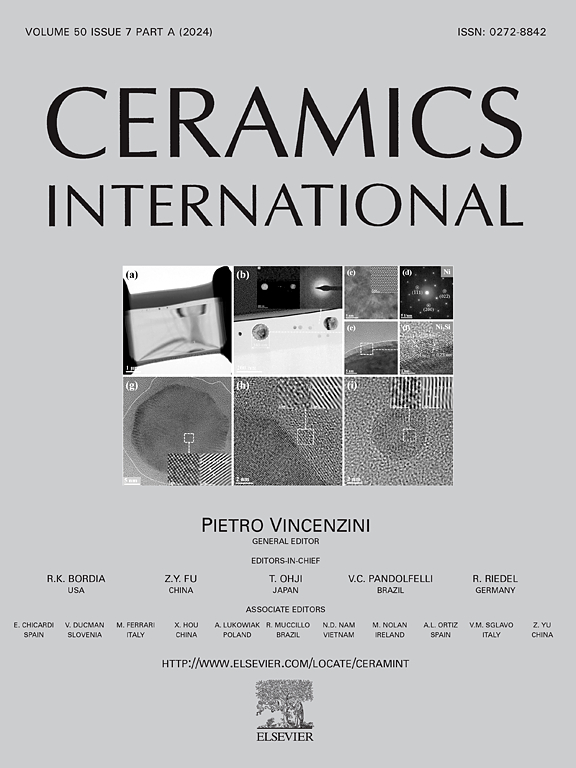Microwave dielectric properties, microstructure, bond characteristics, and Raman spectra of MnMo1-xWxO4 ceramics
IF 5.6
2区 材料科学
Q1 MATERIALS SCIENCE, CERAMICS
引用次数: 0
Abstract
The monoclinic MnMo1-xWxO4 (x = 0.02–0.08) ceramics of C2/m(12) space group were prepared by solid-state reaction at 725–900 °C. Rietveld refinement results indicate that a small amount of MnWO4 secondary phase exists when the sintering temperature is below 850 °C, and the substitution of W6+ can enhance the Q × f value. At 850 °C, pure MnMo0.92W0.08O4 achieves a relative density of 95.9 % and exhibits optimal properties: εr = 7.39 ± 0.06, Q × f = 76,554 ± 1846 GHz, and τf = −67.3 ± 1.06 ppm/°C. The grain size increased with increasing sintering temperature. The ionic polarizability and relative density primarily determine εr. Q × f is predominantly influenced by relative density, with minimal contribution from packing fraction. τf is closely related to bond valence. Phillips-Van Vechten-Levine theory indicated that Mo-O bond parameters, including bond ionicity, lattice energy, and linear thermal expansion coefficient, affected the microwave dielectric properties. Most of the peaks observed in Raman spectroscopy are related to the vibrations of the [MoO4] tetrahedra.
MnMo1-xWxO4陶瓷的微波介电性能、微观结构、键特性和拉曼光谱
采用固相反应,在725 ~ 900℃下制备了C2/m(12)空间基团单斜晶型MnMo1-xWxO4 (x = 0.02 ~ 0.08)陶瓷。Rietveld细化结果表明,当烧结温度低于850℃时,存在少量MnWO4二次相,W6+的取代可以提高Q × f值。850℃时,纯mnmo0.92 w0.080 o4的相对密度达到95.9%,εr = 7.39±0.06,Q × f = 76,554±1846 GHz, τf = - 67.3±1.06 ppm/°C。随着烧结温度的升高,晶粒尺寸增大。离子极化率和相对密度主要决定εr。Q × f主要受相对密度的影响,填料分数的影响最小。τf与键价密切相关。philips - van veechten - levine理论表明,Mo-O键参数(包括键离子性、晶格能和线性热膨胀系数)影响了微波介电性能。在拉曼光谱中观察到的大多数峰与[MoO4]四面体的振动有关。
本文章由计算机程序翻译,如有差异,请以英文原文为准。
求助全文
约1分钟内获得全文
求助全文
来源期刊

Ceramics International
工程技术-材料科学:硅酸盐
CiteScore
9.40
自引率
15.40%
发文量
4558
审稿时长
25 days
期刊介绍:
Ceramics International covers the science of advanced ceramic materials. The journal encourages contributions that demonstrate how an understanding of the basic chemical and physical phenomena may direct materials design and stimulate ideas for new or improved processing techniques, in order to obtain materials with desired structural features and properties.
Ceramics International covers oxide and non-oxide ceramics, functional glasses, glass ceramics, amorphous inorganic non-metallic materials (and their combinations with metal and organic materials), in the form of particulates, dense or porous bodies, thin/thick films and laminated, graded and composite structures. Process related topics such as ceramic-ceramic joints or joining ceramics with dissimilar materials, as well as surface finishing and conditioning are also covered. Besides traditional processing techniques, manufacturing routes of interest include innovative procedures benefiting from externally applied stresses, electromagnetic fields and energetic beams, as well as top-down and self-assembly nanotechnology approaches. In addition, the journal welcomes submissions on bio-inspired and bio-enabled materials designs, experimentally validated multi scale modelling and simulation for materials design, and the use of the most advanced chemical and physical characterization techniques of structure, properties and behaviour.
Technologically relevant low-dimensional systems are a particular focus of Ceramics International. These include 0, 1 and 2-D nanomaterials (also covering CNTs, graphene and related materials, and diamond-like carbons), their nanocomposites, as well as nano-hybrids and hierarchical multifunctional nanostructures that might integrate molecular, biological and electronic components.
 求助内容:
求助内容: 应助结果提醒方式:
应助结果提醒方式:


